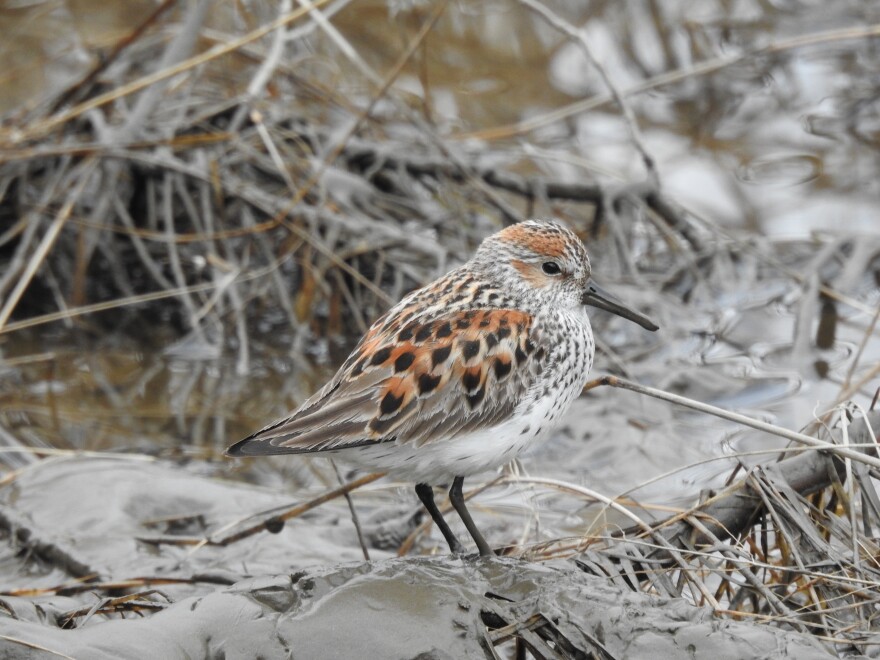Alaska’s western and northern coasts are the breeding area for many species of shorebirds as they travel across the globe to the lower 48, or to Central America or South America.
“It's kind of the breadbasket, as it were, where the babies get born and allow the populations to grow,” said Rick Lanctot, the shorebird coordinator for the migratory bird management division of the United States Fish and Wildlife Service (USFWS). His job is mostly focused on understanding the status and trends of shorebirds, and what affects them and their population sizes.
Lanctot said it’s long been clear that the Yukon-Kuskokwim (Y-K) Delta is one of the most important breeding areas for shorebirds. But until recently, it wasn’t actually clear exactly how many shorebirds relied on the Y-K Delta.
“We were totally winging it,” Lanctot said with a laugh. “We were totally guessing what might be there based on the small little studies that had been done.”
A study in the 1970s had, with very little evidence, proposed that the Y-K Delta supported 100 million shorebirds.
“We thought that was a completely bogus estimate,” said Brian McCaffery, a former wildlife biologist who worked and volunteered for decades in the Y-K Delta.
“So for years,” McCaffery said, “we wanted to be able to, in effect, disprove the 100 million estimate. But also just to demonstrate how important [the Y-K Delta] is for shorebirds.”
It’s an incredibly complex process to actually figure out how many birds are in an area at any given time.
“You can go out there and you say, ‘Well, I saw all of them.' And it's very rare when that's actually true,” McCaffery said.
A study released in 2023 finally set forth scientists’ best estimate, based on years-worth of on-the-ground, intensive observation: the Yukon-Kuskokwim Delta is integral habitat to 7 million shorebirds – 21 species.
“If you compare that number with other areas within Alaska, you will see that the Yukon-Kuskokwim Delta has some of the highest rates of shorebird breeding densities of anywhere in Alaska,” said River Gates with the National Audubon Society. That makes the Y-K Delta one of the most important shorebird habitats in the Americas, along with the National Petroleum Reserve in Alaska (NPR-A).
“I think most people: waterbird biologists, the Yup’ik people that have lived there [...] know the importance. They see the birds arriving every year, and there's a lot of birds there. So it wasn't exactly like we discovered something. We just put a number on what people have been experiencing and seeing for millennia,” Gates said. “And that number allows us to have a better understanding and to protect those populations. Because if that number goes down, then we know that there's a problem.”
Study authors used what’s called a double sampling technique called PRISM, first used on the North Slope, to get a clearer estimate of where birds are, how many there are, and when. Some people went out to 400-by-400-meter plots for 75 minutes to record all the shorebirds they could see, and would repeat the process all over the study area. Others would work in the same area over the whole spring season, recording detailed observations over time.
The study gives a sense of the broad importance of the Y-K Delta to shorebirds, but doesn’t show how those populations are shifting.
To get a clear and ongoing picture of what’s happening to the Y-K Delta’s shorebird populations, biologist McCaffery said that the study should be repeated within the next decade or so.
“A lot is going to happen in 20 years,” McCaffery said. “And for some of these things, if we wait that long to figure out, ‘Okay, is there a problem?’ It's going to be too late.”
The arrivals and departures of bird populations are part of the rhythm of life in Yup’ik and Cup’ik communities, and locals have already seen changes.
“From agency, government and conservation group [perspective], our results are clearly important, but they parallel the knowledge that comes out of the Yup’ik community there in terms of understanding things aren't going the way they used to,” McCaffery said.
Some of the first birds kids here would learn to hunt have seen population declines. Elders say that the tundra is quieter than it used to be as there are fewer and fewer birds.
Lanctot said that follows a global trend – most bird populations are declining.
“Shorebirds are one of the ones that are declining the most. We've lost about 37% of the birds in the last 50 years based on estimates in different parts of the world when you combine all this stuff together,” Lanctot said. “So this is just one little piece of this big picture of trying to understand what It's going on with bird numbers around the world.”
The birds travel thousands of miles across human borders. And Lanctot said that exposes them to compounding threats.
“You know, death by 1,000 cuts kind of a thing,” Lanctot said. “Because, you know, they're traveling over huge expanses of geography across many political kinds of governments that take different approaches to their management, or don't do anything for their management. And so they're just constantly being affected by things. It's amazing they do as well as they do.”
Climate change and development are the biggest threats to shorebird populations. Lanctot and his fellow scientists hope having a more solid sense of the Y-K Delta’s shorebird population can help inform conservation efforts here and in all the other places the birds land.



